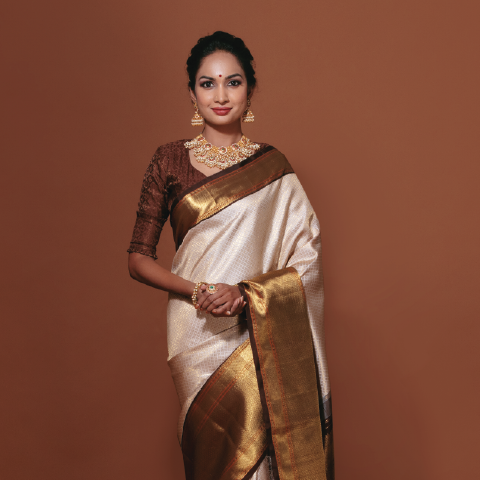From thread to tradition and warp to weft, weaving is an amalgamation of art and science. This is a craft that is spread across multiple hubs across the country and employs more than a million artisans to bring to life a masterpiece, put together not by one, but many hands. The fabric of Indian culture is interwoven with a slew of time-honoured weaves that are highly revered and are passed down through generations of women as an heirloom treasure. And one such weave, which we will be exploring more of in this week's blog, is the Paithani saree.
As the integral centrepiece of Maharashtrian customs for over centuries, the kaleidoscopic Paithani drape carries great cultural significance in every thread and tassel. Its antique origins can be traced back to the medieval town near Aurangabad, Paithan, which was then under the rule of the Satvahana Dynasty. Although this indigenous craft is said to have flourished during the Mughal era, especially under the reign of Aurangazeb. Propagated by the royal dynasties of the region, it was said to have employed the finest silk threads from China and locally spun pure gold zari. Another notable point in its timeline comes later on in the 19th century when the Nizam of Hyderabad invested and ordered an exorbitant quantity of this weave. Legend has it that the popular Paithani motif, Parinda or pheasant bird is the contribution of Begum Niloufer of the Nizam dynasty. Over the years Yeola, a village in the Nashik district, become an additional hub and a commercial centre for Paithani weaving. Flowing with finesse and characterised by luxury, the signature of this handloom weave is the liberal use of gold and vibrant hues in its flora and fauna inspired motifs. It is no wonder that it is the favoured wedding trousseau for Maharashtrian brides.

A genuine and original 6-yard Paithani saree is woven with over 500g of silk threads along with an additional 250g of zari threads. A highly labour-intensive process, it can take anywhere between 6 months to 2 years, based on the design intricacy and complexity.
Loved for its lustre and magical mingling of vibrant hues, the colour palette of this weave is as diverse, distinct and dynamic as the craft itself. Ranging from Aboli (pinkish-peach), Firozi (pastel red and green blend), Orphankhi (greenish-blue) to Mirani (black and red blend), Pophali (yellow) and Vangi (aubergine), the options are endless. The artisans use this spectrum of colours to bring to life a plethora of simple yet stunning nature-inspired motifs. The body is usually adorned with buttis to help shine the spotlight on the border and the pallu. The most popular motifs include Muniya (a kind of parrot), Akruti (squarish almond-shaped flowers), Mor (peacock), Ajanta lotus, musical instruments like the tabla, shehnai and sambal, Koyari (mango) and most importantly the border motifs of Narali (coconut) and Pankha (fan-shaped).

Parallels can be drawn between the Kanchipuram saree and Paithani saree based on the significance they carry to their respective cultures. Draped by women across the state religious ceremonies, auspicious occasions, festivals and weddings, it is fondly called the Queen of Sarees. At Sundari Silks, we take great care to preserve and promote the heritage crafts of our country, such as the Paithani weave, through especially handcrafted collections.






